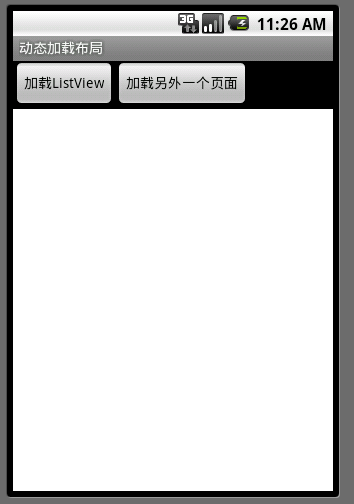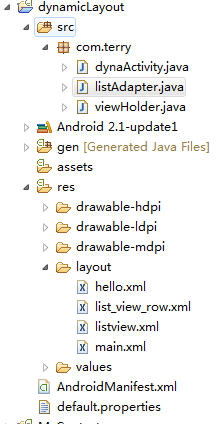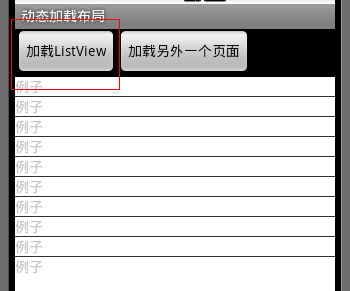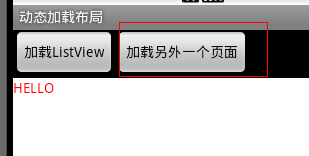Android 动态加载布局
2010-07-25 20:22 Terry_龙 阅读(25837) 评论(13) 编辑 收藏 举报由于前段时间项目需要,需要在一个页面上加载根据不同的按钮加载不同的布局页面,当时想到用 tabhot 。不过美工提供的界面图完全用不上tabhot ,所以想到了动态加载的方法来解决这一需求。在这里我整理了一下,写了一个 DEMO 希望大家以后少走点弯路。
首先,我们先把界面的框架图画出来,示意图如下:

中间白色部门是一个线性布局文件,我喜欢在画图的时候用不同的颜色将一块布局标示出来,方便查看。布局文件代码如下:
<?xml version="1.0" encoding="utf-8"?>
<LinearLayout xmlns:android="http://schemas.android.com/apk/res/android"
android:orientation="vertical" android:layout_width="fill_parent"
android:layout_height="fill_parent">
<LinearLayout android:orientation="horizontal"
android:layout_width="wrap_content" android:layout_height="wrap_content">
<Button android:text="加载ListView" android:id="@+id/Button01"
android:layout_width="wrap_content" android:layout_height="wrap_content">
</Button>
<Button android:text="加载另外一个页面" android:id="@+id/Button02"
android:layout_width="wrap_content" android:layout_height="wrap_content"></Button>
</LinearLayout>
<LinearLayout android:id="@+id/LinearLayout01" android:background="#FFFFFF"
android:layout_width="fill_parent" android:layout_height="fill_parent"></LinearLayout>
</LinearLayout>
<LinearLayout xmlns:android="http://schemas.android.com/apk/res/android"
android:orientation="vertical" android:layout_width="fill_parent"
android:layout_height="fill_parent">
<LinearLayout android:orientation="horizontal"
android:layout_width="wrap_content" android:layout_height="wrap_content">
<Button android:text="加载ListView" android:id="@+id/Button01"
android:layout_width="wrap_content" android:layout_height="wrap_content">
</Button>
<Button android:text="加载另外一个页面" android:id="@+id/Button02"
android:layout_width="wrap_content" android:layout_height="wrap_content"></Button>
</LinearLayout>
<LinearLayout android:id="@+id/LinearLayout01" android:background="#FFFFFF"
android:layout_width="fill_parent" android:layout_height="fill_parent"></LinearLayout>
</LinearLayout>
从上面的效果图可以看出,那块白色的线性布局是用来动态加载传进来的布局文件。好了,我们就来做如果把布局文件动态的加载进来。下面我们一步一步来实现这个效果,首先,先把需要的 XML 勾画出来,分为步骤如下。
- 新建一个布局用来存放 ListView 页面,代码如下:
<?xml version="1.0" encoding="UTF-8"?>
<LinearLayout android:id="@+id/layout"
android:layout_width="fill_parent" android:layout_height="fill_parent"
xmlns:android="http://schemas.android.com/apk/res/android">
<ListView android:id="@+id/ListView01" android:layout_width="wrap_content"
android:layout_height="wrap_content"></ListView>
</LinearLayout> - 新建一个 ListView 每一行数据的样式,代码如下:
<?xml version="1.0" encoding="UTF-8"?>
<LinearLayout android:id="@+id/LinearLayout01"
android:layout_width="fill_parent" android:layout_height="fill_parent"
xmlns:android="http://schemas.android.com/apk/res/android">
<TextView android:text="@+id/TextView01" android:id="@+id/TextView01"
android:layout_width="wrap_content" android:layout_height="wrap_content"></TextView>
</LinearLayout> - 新建另外一个页面,用来区分此页面是动态加载的,代码如下:
<?xml version="1.0" encoding="UTF-8"?>
<LinearLayout android:id="@+id/hellolayout"
android:layout_width="fill_parent" android:layout_height="fill_parent"
xmlns:android="http://schemas.android.com/apk/res/android">
<TextView android:text="HELLO"
android:layout_width="wrap_content" android:layout_height="wrap_content"></TextView>
</LinearLayout> - 实现ListView 的添充数据,这里不详细介绍如何填充ListView 每行数据,有不解的朋友可以回头看我写的文章:点击这里 ,代码如下:
package com.terry;
import java.util.ArrayList;
import java.util.HashMap;
import android.content.Context;
import android.view.LayoutInflater;
import android.view.View;
import android.view.ViewGroup;
import android.widget.BaseAdapter;
import android.widget.TextView;
public class listAdapter extends BaseAdapter {
ArrayList<HashMap<String, Object>> list = new ArrayList<HashMap<String, Object>>();
private LayoutInflater inflater;
public listAdapter(Context contex)
{
inflater=LayoutInflater.from(contex);
HashMap<String, Object> map=new HashMap<String, Object>();
for (int i = 0; i < 10; i++) {
map.put("name", "例子");
list.add(map);
}
}
@Override
public int getCount() {
// TODO Auto-generated method stub
return list.size();
}
@Override
public Object getItem(int position) {
// TODO Auto-generated method stub
return list.get(position);
}
@Override
public long getItemId(int position) {
// TODO Auto-generated method stub
return position;
}
@Override
public View getView(int position, View convertView, ViewGroup parent) {
// TODO Auto-generated method stub
final viewHolder myHolder;
if (convertView==null) {
myHolder=new viewHolder();
convertView=inflater.inflate(R.layout.list_view_row, null);
myHolder.tv=(TextView)convertView.findViewById(R.id.TextView01);
convertView.setTag(myHolder);
}
else
{
myHolder=(viewHolder)convertView.getTag();
}
myHolder.tv.setText(list.get(position).get("name").toString());
return convertView;
}
} - 项目大纲如下图:

- 好了,到此我们的准备工作就己经完成,接下来就是要教大家如何实现动态加载上面所画的布局页面了,先看一下效果图:

点击第一个按钮
点击第二个按钮 -
动态加载代码如下:上面通过使用LayoutInflater 每次点击按钮时候去读取布局文件,然后找到布局文件里面的各个VIEW 操作完VIEW 后加载进我们setContentView 方面里面的要放的布局文件里面,每次动态加载文件必需 调用 removeAllViews方法,清除之前的加载进来的 View 。是不是很简单?当然动态加载VIEW 还有许多种方法,多尝试不同写法。可能会领会不一样的心得,祝你早上掌握android 的开发技术。
package com.terry;
import android.app.Activity;
import android.graphics.Color;
import android.os.Bundle;
import android.view.LayoutInflater;
import android.view.View;
import android.view.View.OnClickListener;
import android.widget.Button;
import android.widget.LinearLayout;
import android.widget.ListView;
import android.widget.TextView;
public class dynaActivity extends Activity {
/** Called when the activity is first created. */
@Override
public void onCreate(Bundle savedInstanceState) {
super.onCreate(savedInstanceState);
setContentView(R.layout.main);
final LayoutInflater inflater = LayoutInflater.from(this);
Button btn = (Button) findViewById(R.id.Button01);
Button btn2 = (Button) findViewById(R.id.Button02);
final LinearLayout lin = (LinearLayout) findViewById(R.id.LinearLayout01);
btn.setOnClickListener(new OnClickListener() {
@Override
public void onClick(View v) {
// TODO Auto-generated method stub
LinearLayout layout = (LinearLayout) inflater.inflate(
R.layout.listview, null).findViewById(R.id.layout);
ListView lv=(ListView)layout.getChildAt(0);
lv.setAdapter(new listAdapter(dynaActivity.this));
lin.removeAllViews();
lin.addView(layout);
}
});
btn2.setOnClickListener(new OnClickListener() {
@Override
public void onClick(View v) {
// TODO Auto-generated method stub
LinearLayout layout = (LinearLayout) inflater.inflate(
R.layout.hello, null).findViewById(R.id.hellolayout);
TextView lv=(TextView)layout.getChildAt(0);
lv.setTextColor(Color.RED);
lin.removeAllViews();
lin.addView(layout);
}
});
}
}
Tip:因为是基于VIEW 操作,因此你可以用 Animation 的动画效果使其更换界面更为自然,观赏性更强。



【推荐】国内首个AI IDE,深度理解中文开发场景,立即下载体验Trae
【推荐】编程新体验,更懂你的AI,立即体验豆包MarsCode编程助手
【推荐】抖音旗下AI助手豆包,你的智能百科全书,全免费不限次数
【推荐】轻量又高性能的 SSH 工具 IShell:AI 加持,快人一步
· 如何编写易于单元测试的代码
· 10年+ .NET Coder 心语,封装的思维:从隐藏、稳定开始理解其本质意义
· .NET Core 中如何实现缓存的预热?
· 从 HTTP 原因短语缺失研究 HTTP/2 和 HTTP/3 的设计差异
· AI与.NET技术实操系列:向量存储与相似性搜索在 .NET 中的实现
· 10年+ .NET Coder 心语 ── 封装的思维:从隐藏、稳定开始理解其本质意义
· 地球OL攻略 —— 某应届生求职总结
· 提示词工程——AI应用必不可少的技术
· Open-Sora 2.0 重磅开源!
· 周边上新:园子的第一款马克杯温暖上架